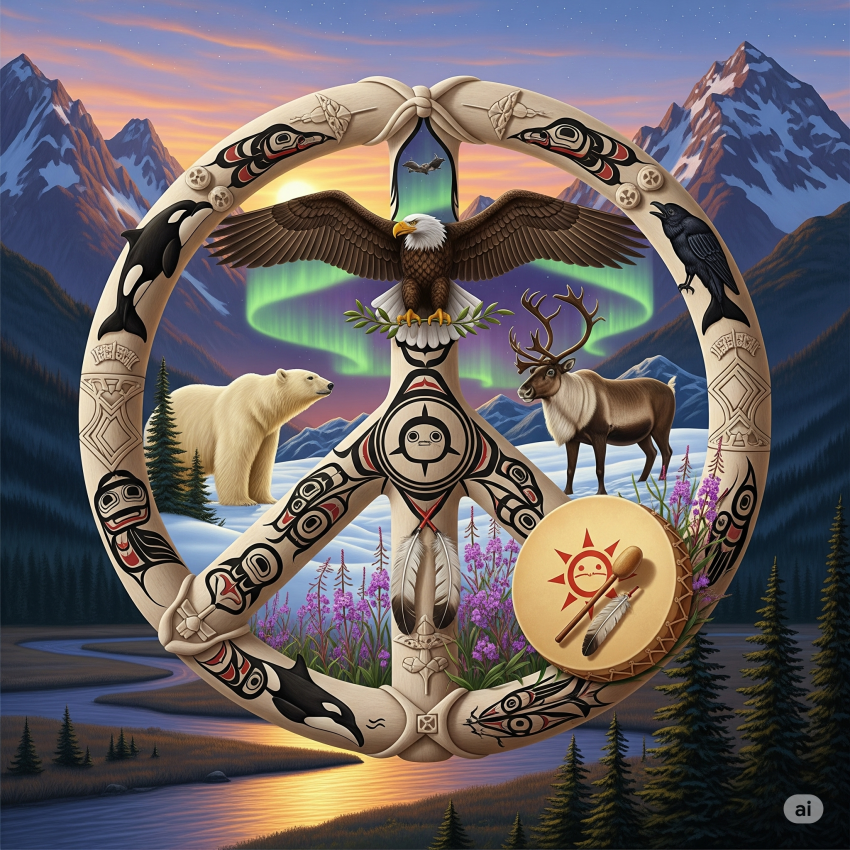What Sacred Land Teaches About Peace
When President Trump and Vladimir Putin met in Alaska on August 15, 2025, seeking to end the war in Ukraine, most analysis focused on geopolitical strategy and diplomatic tactics. But viewing this summit through Indigenous wisdom reveals profound lessons about relationship, sovereignty, and the path to lasting peace that conventional diplomacy missed entirely.
The Sacred Geography of Power
Alaska is not just a convenient meeting location between two superpowers—it is sacred ground that holds deep memories about sovereignty, relationship, and the consequences of treating land as commodity. As William L. Iggiagruk Hensley, a descendant of Inupiaq Eskimos, explains, there are “two histories of how Alaska came to be American”—the Russian-American diplomatic story, and the perspective of Indigenous peoples “who have lived in Alaska for thousands of years.”
The name Alaska itself derives from the Aleut word “alyeska,” meaning “great land”—speaking to the Indigenous understanding of this place as more than territory, but as a living, sacred entity deserving of reverence and relationship.
The Colonial Shadow Over Diplomacy
From an Indigenous perspective, the summit cannot be separated from the colonial history that made it possible. When Russia “sold” Alaska in 1867, it included about 60,000 Indigenous people—approximately 50,000 living entirely outside Russian jurisdiction. The Russian colonial period had already devastated populations: on the Aleutian Islands alone, the Aleut population plummeted to just 1,500 in the first 50 years due to violence, disease, and enslavement.
Most significantly, the 1867 Treaty of Cession classified Alaska Natives into “civilized groups” who would become regular U.S. citizens with no special relationship, and “uncivilized groups” subject to federal Indian law. This denied most Alaska Natives any aboriginal claim to land and resources—a denial that wasn’t fully resolved until 1971, when the Alaska Native Claims Settlement Act formally extinguished Indigenous title in exchange for 44 million acres and nearly $1 billion.
What Indigenous Diplomacy Teaches
Traditional Indigenous diplomacy, as practiced by nations like the Haudenosaunee with their Great Law of Peace, emphasized “rituals for establishing relationships and expressions of sacred obligations.” These traditions stand in stark contrast to what unfolded in Alaska.
The Absence of Ceremony: Indigenous peace-making begins with ceremony to acknowledge the sacred nature of the land, the ancestors, and future generations who will inherit the consequences of decisions made. The summit’s red carpet and fighter jets represented power projection, not sacred relationship.
Missing Seven-Generation Thinking: Traditional Indigenous decision-making considers impacts seven generations into the future. Alaska Native peoples maintain “unparalleled Indigenous traditional ecological knowledge acquired over millennia” and understand ecosystem interconnections. The summit focused on immediate geopolitical gains rather than long-term consequences for all life.
No Recognition of Original Peoples: Despite meeting on Indigenous homelands with their own sovereign traditions, neither leader acknowledged the original peoples of Alaska or sought their counsel. Arctic Indigenous leaders have held six “Arctic Leaders’ Summits” since 1991, understanding that “Arctic Indigenous communities are at the nexus of regional peacebuilding, economic development, human rights, and climate justice.”
The Land as Teacher
From an Indigenous perspective, Alaska itself was offering teachings during this summit. The Ukraine war connects to Arctic militarization, which connects to climate change, which affects Indigenous communities first and most severely. More than 40 primarily Indigenous villages in Alaska must be relocated due to coastal erosion and storm surges, with Indigenous peoples suffering these losses first while their “traditions, ways of lives, and cultures may follow.”
The Inuit story of Sassuma Aarna—the mother of the sea—teaches that when humans pollute the land and seas, life-giving forces withdraw their support until the oceans are cleansed. Only through right relationship can abundance return.
The Profound Irony
The irony is profound: Alaska, purchased as a “frozen wasteland,” has proven invaluable precisely because Indigenous peoples maintained its ecological richness for millennia through relationship-based stewardship. The same wisdom that preserved Alaska’s abundance could guide us toward true peace—if we were humble enough to listen.
Indigenous wisdom suggests that lasting peace requires ceremony and sacred acknowledgment of the land and original peoples, seven-generation thinking that considers long-term consequences, ecological integration recognizing that human conflicts affect all of creation, relationship over transaction through reciprocity and respect, and inclusion of Indigenous voices who understand the land’s needs and teach sustainable relationships.
While the summit achieved no breakthrough, it revealed the limitations of diplomacy disconnected from the sacred relationships that sustain all life. True peace may require learning from those who have successfully maintained harmony with the land for thousands of years.

